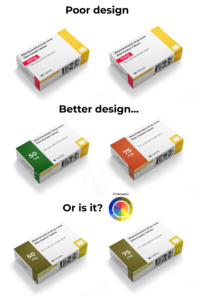Tips and tricks for user-centric design
27 September 2023
Leanne Yip, Head of Design and Usability outlines some tips and tricks for designing patient-centric medical devices.
As humans, we are not perfect. We make mistakes, poor judgments, and errors. But there are good reasons why we behave as we do, for example:
“I just got off a flight from the US, so I am exhausted, jet-lagged and making rash decisions”.
We also have limitations:
- Sight, e.g. we might wear glasses
- Dexterity, e.g. Arthritis
- Learning difficulties, e.g. Dyslexia
The way we perceive, read, interpret and act can be very different, especially when looking at patient populations.
Packaging design example
If we do not understand who our user is and the environment in which the product is used, it can be difficult to critique our own designs.
Imagine we were designing a medication packaging for a patient who takes multiple different oral chemotherapy drugs depending on the stage of their regime. In the first set of images, the 50mg and 75mg boxes look very similar. Making it difficult to recognise the difference if you are in a rush or you might be tired or have a visual impairment.
The second set of images shows a better design where the concentrations are illustrated in a larger font and have different colour backgrounds. However, if we knew that 8% of men have some form of red-green colour deficiency, we might want to rethink our colour choices. The final images in the picture show what a person with protanopia would see, there is no difference in colours. Photoshop has a built-in proof viewing option for protanopia and deuteranopia colour blindness.

Talking to the right participants
Depending on the device you may have several users who interact with the product, and they may have roles. E.g. parent, caregiver, maintenance and health care practitioner (HCP).
The FDA views user populations as distinct when their characteristics would likely affect their interactions with the device or when the tasks, they perform on the device would be different. For example, some devices will have users in different age categories (pediatric, adolescent, adult, or geriatric) or users in different professional categories (e.g., health care provider, lay user).
Below is a list of user characteristics you may want to investigate before recruiting user groups for testing.
Checklist of user characteristics to investigate:
- Physical size, strength, and stamina
- Physical dexterity, flexibility, and coordination
- Sensory abilities (i.e., vision, hearing, tactile sensitivity)
- Cognitive abilities, including memory,
- Medical condition for which the device is being used
- Comorbidities (i.e., multiple conditions or diseases)
- Literacy and language skills
- General health status
- Mental and emotional state
- Level of education and health literacy relative to the medical condition involved
- General knowledge of similar types of devices
- Knowledge of and experience with the particular device
- Ability to learn and adapt to a new device
Think about the environment the product is used in
It is important to think about where your product is going to be stored, used, and disposed of because it could influence how the user interacts with it. For example, the characteristics of the room such as the lighting may make a digital user interface unreadable. Additionally, if there may be other items in the room that are similar to the one you are testing, making it difficult to identify the correct one e.g different cartridges of different concentrations.
You may consider conducting ethnographic research if the product’s interactions rely heavily on the environment it is placed in. The study technique involves observing people in their natural environment to find out how they interact with the world around them.
Checklist- characteristics of the environment to investigate:
- The lighting level might be low or high, making it hard to see device displays or controls.
- The noise level might be high, making it hard to hear device operation feedback or audible alerts and alarms or to distinguish one alarm from another
- The room could contain multiple models of the same device, component or accessory, making it challenging to identify and select the correct one.
- The room might be full of equipment or clutter or busy with other people and activities, making it difficult for people to maneuver in the space and providing distractions that could confuse or overwhelm the device user.
- The device might be used in a moving vehicle, subjecting the device and the user to jostling and vibration that could make it difficult for the user to read a display or perform fine motor movements.
When and how to conduct user testing
To evaluate a design, we must conduct user testing to discover user feedback and find causes for use errors. If you know a design decision will be made based on the user interface and it will significantly impact part of your development, it is more cost and time-effective to start user testing prior to that design decision. It is recommended to conduct a series of formative user tests (at least 2-3 for medical devices) and it can be more productive to conduct small-scale tests rather than fewer large-scale tests.
Conclusion
User studies are a vital part of making sure that your products are successful on the market and used effectively by all the relevant users. By designing your product and packaging with a deep understanding of the user, you can instil confidence that you are developing the right product to meet user needs.
Contact Leanne to find out how we can help you design your next device.


